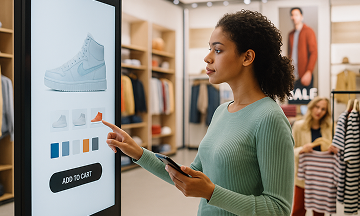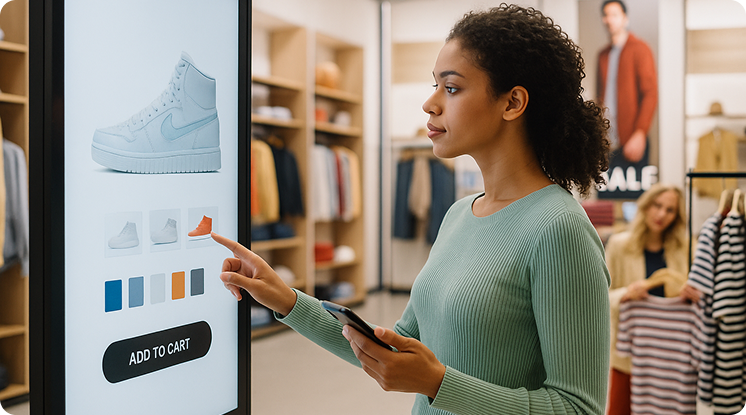
The Future of Shopping:
How Phygital Experiences Are Redefining Retail
The Future of Shopping:
How Phygital Experiences Are Redefining Retail

Walk into a store today, and you’ll realize you’re not just shopping anymore, you’re navigating a hybrid universe. A QR code on a mannequin pulls up styling tips. A mirror lets you try on outfits you never physically touched. Your app nudges you with a reminder: “Don’t forget the shoes you checked online.”
Welcome to the world of phygital retail where physical and digital merge so seamlessly, you barely notice the line between them.
For brands, this isn’t a gimmick. It’s survival. Customers don’t think in “channels” anymore. They don’t care if they’re on Instagram, on your app, or standing in your store. They expect one fluid journey.
Nike understood this early. Their House of Innovation stores in New York and Paris let shoppers scan mannequins to pull up product details, or customize sneakers through AR. Zara, on the other hand, turned its London pop-up into a digital-first store — samples on display, orders placed via touchscreens, and items delivered to your door.
And then there’s Amazon Go, which pushed the idea to its edge: grab your items, walk out, and let AI do the rest. No checkout, no queues, just frictionless flow.
What ties these together isn’t just technology. It’s a mindset of continuity. A belief that a customer should glide between browsing, trying, buying, and sharing without friction, without breaks.
Phygital is more than tech. It’s about human-centered design. Smart mirrors aren’t about flashing AR graphics; they’re about helping someone feel more confident in a purchase. Mobile-first store maps aren’t just about convenience; they’re about respect for your customers’ time.
Phygital isn’t the future. It’s the present. And the brands that master it will be the ones that feel less like retailers and more like companions in their customers’ daily lives.
Walk into a store today, and you’ll realize you’re not just shopping anymore, you’re navigating a hybrid universe. A QR code on a mannequin pulls up styling tips. A mirror lets you try on outfits you never physically touched. Your app nudges you with a reminder: “Don’t forget the shoes you checked online.”
Welcome to the world of phygital retail where physical and digital merge so seamlessly, you barely notice the line between them.
For brands, this isn’t a gimmick. It’s survival. Customers don’t think in “channels” anymore. They don’t care if they’re on Instagram, on your app, or standing in your store. They expect one fluid journey.
Nike understood this early. Their House of Innovation stores in New York and Paris let shoppers scan mannequins to pull up product details, or customize sneakers through AR. Zara, on the other hand, turned its London pop-up into a digital-first store — samples on display, orders placed via touchscreens, and items delivered to your door.
And then there’s Amazon Go, which pushed the idea to its edge: grab your items, walk out, and let AI do the rest. No checkout, no queues, just frictionless flow.
What ties these together isn’t just technology. It’s a mindset of continuity. A belief that a customer should glide between browsing, trying, buying, and sharing without friction, without breaks.
Phygital is more than tech. It’s about human-centered design. Smart mirrors aren’t about flashing AR graphics; they’re about helping someone feel more confident in a purchase. Mobile-first store maps aren’t just about convenience; they’re about respect for your customers’ time.
Phygital isn’t the future. It’s the present. And the brands that master it will be the ones that feel less like retailers and more like companions in their customers’ daily lives.
